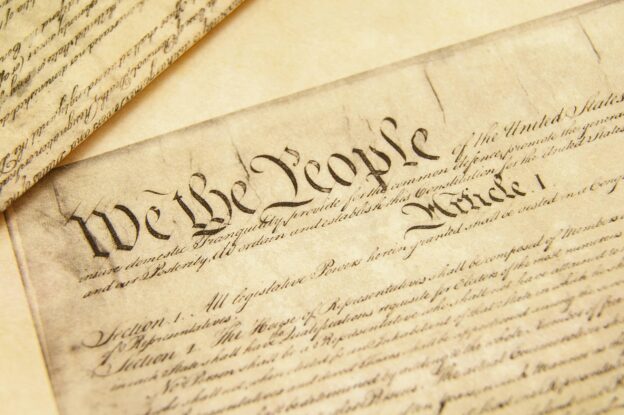Historical Context
During the summer of 1787, delegates came to the Constitutional Convention in Philadelphia intensely worried about the future of the United States. The fragile new experiment in self-government appeared to be headed down the road to failure. States were divided by their economic interests, religious beliefs, and reliance on slavery. The Articles of Confederation had created a confederation government during the Revolutionary War, but Congress’ inability to collect taxes or call-in state debts left Continental Army soldiers unsupplied, cold, and hungry.
A few years after victory in the Revolutionary War, states bickered over boundary disputes, printed their own currencies (causing inflation), and violated the peace treaty that ended the war. Britain watched and waited patiently for the American experiment to collapse, ready to move back in and regain some of its resources lost in the war.
As the delegates came to the Constitutional Convention, they knew they had monumental problems to solve. How would they navigate their differences and save the American experiment? They knew there would be no United States unless they could find ways to accommodate one another across their differences.
About the Course
In steps 2-6, you will learn about the dire condition of the American Union soon after the Revolutionary War. You will learn about some issues dividing the nation and the challenges facing the delegates of the Constitutional Convention as they gathered to save their country from failure.
In steps 6-7, you will learn how the delegates agreed to a process of giving space to work through issues. You will learn about the rules for debates in the Convention. Following this process built trust among the delegates.
In steps 8-12, you will learn about some of the critical agreements the delegates navigated across their differences, including representation in the national legislature and negotiations over slavery.
Finally, in step 13, you will be guided in a class discussion exploring how we can look to the Constitutional Convention as a model for how to navigate our deep differences today. Successfully navigating our differences makes it possible for our experiment in liberty to continue and keep our Union.
Learning Objectives
By using Getting to Union: Navigating Differences in the Constitutional Convention, you will…
- Understand the fragile state of the United States at the time of the creation of the U.S. Constitution, including deep divisions across the states.
- Explore how the delegates in the Constitutional Convention created a space to address issues where they disagreed.
- Identify that creating a space in the Constitutional Convention to address issues built trust among the delegates and made linchpin compromises over representation and slavery possible.
- Discuss possible ways today we can navigate our differences to keep our Union.





